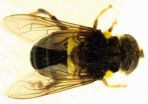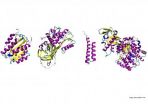(Press-News.org) The rate of chemical processes in cells is dictated by the speed of movement (diffusion) of molecules needed for a given reaction. Using a versatile method developed at the Institute of Physical Chemistry of the Polish Academy of Sciences in Warsaw, researchers were able to predict for the first time the diffusion coefficients of all proteins in Escherichia coli. The achievement is important not only for biologists and chemists, but also for... transport companies.
Understanding of chemical foundations of life requires knowledge about the rate of chemical reactions in cells. The rates of these reactions depend on how fast the molecules taking part in reactions move (diffuse) in the cytoplasm. Prof. Robert Hołyst's research team from the Institute of Physical Chemistry of the Polish Academy of Sciences in Warsaw (IPC PAS) managed to determine – for the first time – the diffusion coefficients for virtually all the proteins occurring in Escherichia coli. The method developed by the researchers can also be used for other cells.
The movements of molecules in cells resemble a bit what's going on in railway stations. But the differences are obvious at first glance. "Regular trains leave stations at fixed times, whereas in cells transport processes take place virtually all the time. That's why it doesn't make sense to ask what time does the train with specific molecules leave the station. But it definitely makes sense to ask how fast the train with specific molecules is moving!", explains Prof. Robert Hołyst (IPC PAS).
Transport efficiency of chemical compounds in cells became inspiring for many transport companies. There's talk of biologistics as modelling vehicle or rail transport by looking up to what's going on inside the cells. Prof. Hołyst, however, has no illusions about that: "Everyone is delighted, for in cells the transport is so wonderfully resistant to perturbations. They forget, however, that the transport results from random fluctuations, in addition occurring in a small volume, where viscosity depends not only on the medium, but also on the size of the viscosity probe! I wish good luck all those who want to transfer processes occurring in physically so different environment to our roads. Biologistics works excellent, but inside cells only!".
Supported by grants from the National Science Center and the Ministry of Science and Higher Education as well as by programs from the Foundation for Polish Science, the research published in the "Bioinformatics" journal focused on the rate of diffusion of protein molecules in the Escherichia coli cytoplasm.
"The viscosity inside mammalian cells is relatively low, only 60 times higher than that of water. But bacteria are considerably smaller, everything is more crowded. The macroscopic viscosity there is up to 26,000 times higher than that of water. This is really dramatic difference!", concludes Dr Tomasz Kalwarczyk (IPC PAS).
Earlier research of Prof. Hołyst's team allowed for concluding that viscosity experienced by molecules is not only medium, i.e., solvent dependent, but also depends on the size and shape of molecules. Therefore, in the same medium, molecules differing in shape and size can experience very low viscosity (nanoviscosity) or macroscopic viscosity that is up to several thousand times higher. The previous methods for predicting diffusion coefficients in cytoplasm have not accounted for the effect.
Experimental determination of the diffusion rates of chemical compounds in bacterial cells is both time consuming and difficult. As a result, diffusion coefficients have been measured only for a very limited number of compounds in only some bacterial cells. That's why the researchers from the IPC PAS developed a method for predicting diffusion coefficients for various compounds and media. For that purpose they used their own formulae, accounting for nanoviscosity and macroscopic viscosity, and a few dozens of diffusion coefficients of macromolecules in Escherichia coli taken from the literature. This was a basis for construction of a scale-dependent viscosity reference curve that could be used to determine diffusion coefficients of remaining compounds.
The database constructed at the IPC PAS contains diffusion coefficients for complete proteome of Escherichia coli. It includes over 6000 macromolecules, with about 4300 gene-expressed amino acid chains and their various, often multiple combinations (polymers), created both by the same chains (homomers), and by different amino acids (heteromers).
"Because of easy access to the literature data, we created a database only for molecules occurring in Escherichia coli. Our method could be, however, adapted for virtually any cell and every molecule, for instance for determining diffusion coefficients of sugars in mammalian cells", stresses Dr Marcin Tabaka (IPC PAS).
INFORMATION:
This press release was prepared thanks to the NOBLESSE grant under the activity "Research potential" of the 7th Framework Programme of the European Union.
The Institute of Physical Chemistry of the Polish Academy of Sciences (http://www.ichf.edu.pl/) was established in 1955 as one of the first chemical institutes of the PAS. The Institute's scientific profile is strongly related to the newest global trends in the development of physical chemistry and chemical physics. Scientific research is conducted in nine scientific departments. CHEMIPAN R&D Laboratories, operating as part of the Institute, implement, produce and commercialise specialist chemicals to be used, in particular, in agriculture and pharmaceutical industry. The Institute publishes approximately 200 original research papers annually.
CONTACTS:
Prof. Robert Hołyst
Institute of Physical Chemistry of the Polish Academy of Sciences
tel. +48 22 3433123
email: rholyst@ichf.edu.pl
Dr Tomasz Kalwarczyk
Institute of Physical Chemistry of the Polish Academy of Sciences
tel. +48 22 3433231
email: tkalwarczyk@ichf.edu.pl
Dr Marcin Tabaka
Institute of Physical Chemistry of the Polish Academy of Sciences
tel. +48 22 3433123
email: mtabaka@ichf.edu.pl
SCIENTIFIC PAPERS:
"Biologistics – diffusion coefficients for complete proteome of Escherichia coli"; Tomasz Kalwarczyk, Marcin Tabaka, Robert Hołyst; Bioinformatics; doi: 10.1093/bioinformatics/bts537
RELATED LINKS:
http://www.ichf.edu.pl/
Website of the Institute of Physical Chemistry of the Polish Academy of Sciences.
http://www.ichf.edu.pl/press/
Press releases of the Institute of Physical Chemistry of the PAS.
Biologistics: How fast do chemical trains move in living cells?
2013-01-31
ELSE PRESS RELEASES FROM THIS DATE:
24 new species of flower fly have been found in Central and Southern America
2013-01-31
A team of scientists have described twenty four new species of dipterans belonging to Quichuana genus, of which only a further 24 species were known. The researchers, including two Spanish biologists, have been studying the forests of Central and Southern America for ten years and they have now published their results in the 'Zoological Journal of the Linnean Society'.
A ten-year study in forests of the American continent has resulted in the description of 24 new insect species from the Quichuana genus that are also known as 'flower flies'.
Up until now only a further ...
Rehabilitation therapies can lead to recovery from chronic fatigue syndrome
2013-01-31
Research led by Queen Mary, University of London, has shown that recovery from chronic fatigue syndrome (CFS) is possible for some patients, and has identified two treatments most likely to lead to recovery.
The latest results from the PACE trial* show that cognitive behaviour therapy (CBT) and graded exercise therapy (GET), as supplements to specialist medical care, increase the likelihood of recovery from CFS three-fold compared to other treatments studied. The trial, carried out in collaboration with researchers from King's College London, the University of Oxford ...
The humble 'virtual chimney' fences that could reduce the impact of airport pollution
2013-01-31
Simple 'blast' fences called baffles could deliver improvements in air quality for people living near airports, new research has found.
Placed behind a runway, the baffles could serve as a 'virtual chimney', funnelling emissions from aircraft engines upwards where they can disperse more effectively, thereby reducing the environmental impact on people living nearby.
Prototype baffles have been tested by a team of researchers from Manchester Metropolitan University, Cranfield University, University of Southampton and the University of Cambridge, with funding from the ...
Disulfiram: New support for an old addiction drug
2013-01-31
Philadelphia, PA, January 31, 2013 – Disulfiram was the first medication approved for the treatment of alcoholism over 50 years ago. It works, at least in part, by preventing the metabolism of an alcohol by-product, acetaldehyde. High levels of acetaldehyde in the body quickly cause unpleasant symptoms, including nausea, vomiting, headache, and accelerated heart rate. Thus, disulfiram provides a very strong incentive to avoid drinking.
Beginning in the late 1990s, a series of studies conducted at Yale University found that disulfiram reduced the consumption of cocaine, ...
Protein origami: Quick folders are the best
2013-01-31
Proteins are elementary building blocks of life. They often perform vital functions. In order to become active, proteins have to fold into three-dimensional structures. Misfolding of proteins leads to diseases such as Alzheimer's or Creutzfeld-Jakob. So which strategies did nature develop over the course of evolution to improve protein folding?
To examine this question, the chemist Dr. Frauke Gräter (Heidelberg Institute for Theoretical Studies) looked far back into the history of the Earth. Together with her colleague Prof. Gustavo Caetano-Anolles at the University of ...
A possible answer for protection against chemical/biological agents, fuel leaks, and coffee stains
2013-01-31
A recent discovery funded by the Air Force Office of Scientific Research (AFOSR) may very well lead to a process that not only benefits every uniformed service member of the Department of Defense, but everyone else as well: protection from Chemical/Biological agents, to self-cleaning apparel, to effortless thermal management, to fuel purification as well as enhanced control of leaks—especially oil and fuels.
In 2006, AFOSR Program Manager Dr. Charles Lee funded Professor Gareth McKinley at the Massachusetts Institute of Technology exploring nanocomposite technology ...
Second-generation CT scanner substantially reduces radiation exposure
2013-01-31
OAK BROOK, Ill. (January 31, 2013) – Researchers using a newly approved advanced computed tomography (CT) system were able to significantly reduce radiation exposure in patients undergoing coronary CT angiography (CCTA), according to a new study published online in the journal Radiology.
"Radiation exposure during diagnostic imaging is a substantial public concern," said Marcus Y. Chen, M.D., lead author of the study from the advanced cardiovascular imaging laboratory at the National Institutes of Health in Bethesda, Md. "Minimizing radiation exposure while maintaining ...
Corn cobs eyed for bioenergy production
2013-01-31
This press release is available in Spanish.
Corn crop residues are often left on harvested fields to protect soil quality, but they could become an important raw material in cellulosic ethanol production. U.S. Department of Agriculture (USDA) research indicates that soil quality would not decline if post-harvest corn cob residues were removed from fields.
This work, led by Agricultural Research Service (ARS) soil scientist Brian Wienhold, supports the USDA priority of developing new sources of bioenergy. ARS is USDA's chief intramural scientific research agency.
Wienhold ...
Gum disease found to worsen infection in animal model of AIDS
2013-01-31
Texas Biomed scientists in San Antonio have found that moderate gum disease in an animal model exposed to an AIDS- like virus had more viral variants causing infection and greater inflammation. Both of these features have potential negative implications in long term disease progression, including other kinds of infections, the researchers say in a new report.
The public health message from the study is that even mild inflammation in the mouth needs to be controlled because it can lead to more serious consequences, said Luis Giavedoni, Ph. D, a Texas Biomed virologist and ...
Flat boron by the numbers
2013-01-31
It would be a terrible thing if laboratories striving to grow graphene from carbon atoms kept winding up with big pesky diamonds.
"That would be trouble, cleaning out the diamonds so you could do some real work," said Rice University theoretical physicist Boris Yakobson, chuckling at the absurd image.
Yet something like that keeps happening to experimentalists working to grow two-dimensional boron. Boron atoms have a strong preference to clump into three-dimensional shapes rather than assemble into pristine single-atom sheets, like carbon does when it becomes graphene. ...


